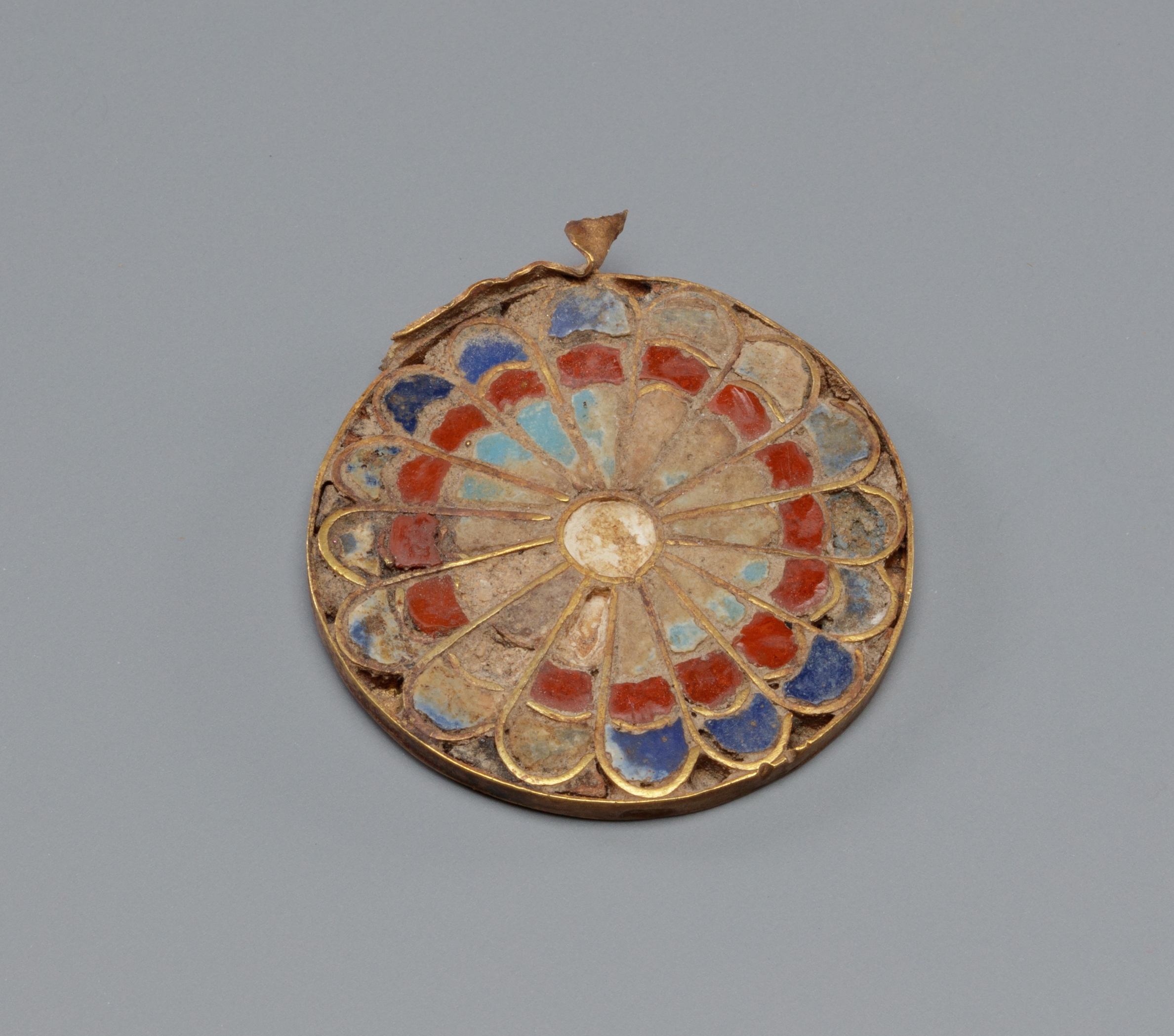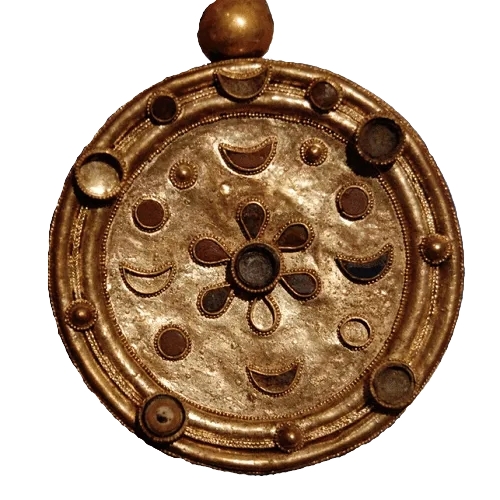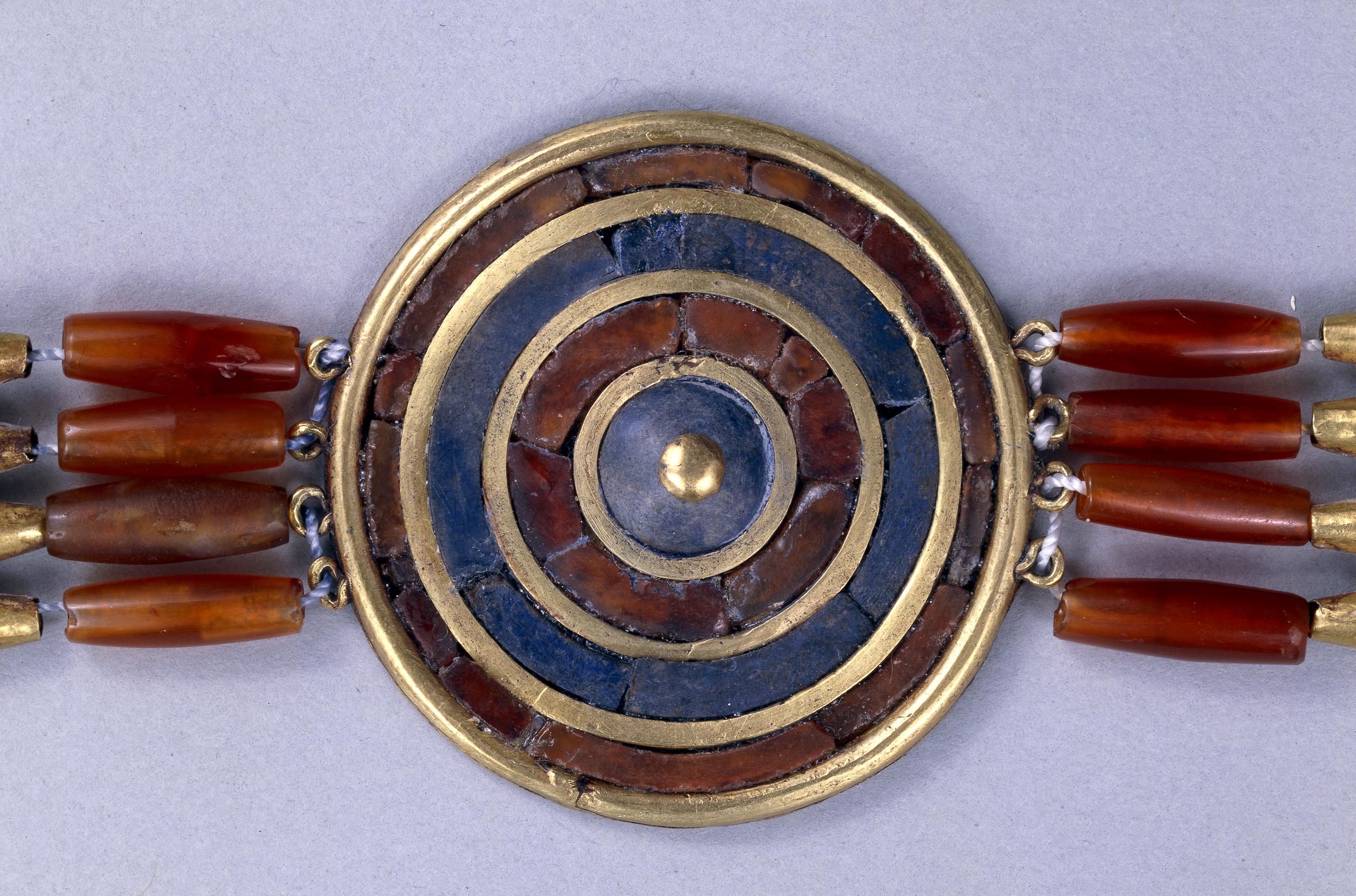British museum EA63438
https://www.britishmuseum.org/collection/object/Y_EA63438
Egypt: Asyut (Governorate): Matmar, 2100 BC; diam. 4.8 cm; cooper, glass, carnelian.
“Description
A disc of copper worked in ‘repoussé’: the hollows are inlaid with segments of cornelian and green and black glazed composition. One black and two green inlays alternate, with red in between each two green inlays. The inlays are very thin slivers mounted on a bed of cement. On the reverse side the rings for suspension have corroded away, as has part of the disc.
Curator’s comments
Found wrapped in a piece of cloth behind the neck of a three-year-old child. According to Brunton the ornament was damaged when buried. […] It was probably intended to be sewn onto a cloth head-band.
Cf. E. Chassinat & C. Palanque, ‘Une campagne de fouilles dans la nécropole d’Assiout. Institut français d’archéologie orientale du Caire. Mémoires publiés par les Membres’, vol. 24 (Cairo, 1911), pl.XXVI: represented on the head-band worn on a cartonnage mummy mask, from tomb 7. pit III, Asyut.”
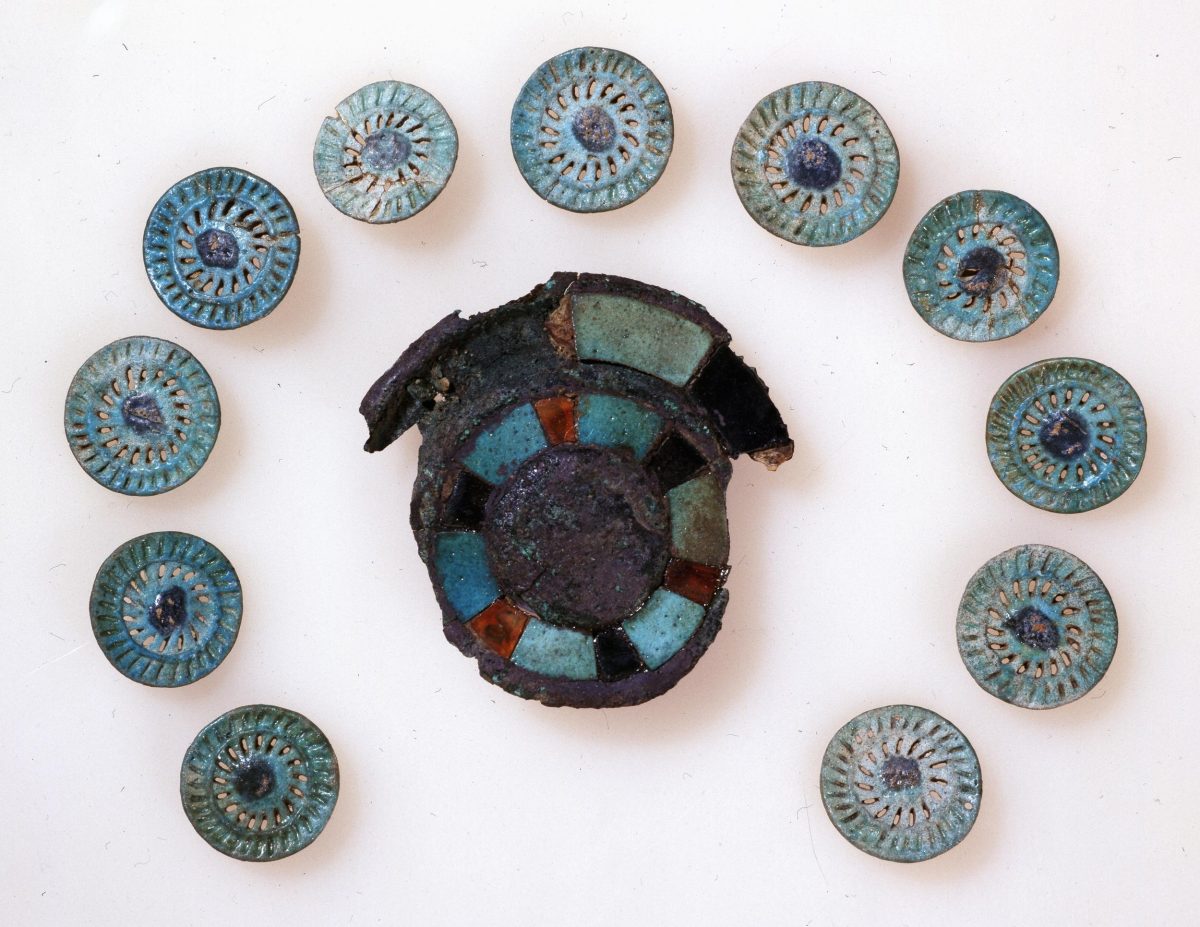
Also from this burial: necklaces (1931,1009.40 & 1931,1009.41), pendants (1931,1009.36-9)
“Matmar, Tomb 306
The tomb of a child “of three years” at Matmar yielded a very similar disc-shaped object. The description of the find circumstances is as follows: “On the head, outside linen wrappings were two strings of amulets (no beads); these were of fourteen different types and numbered…294 in all. Round the neck were two strings of beads of blue faience, one of rings with a steatite cylinder, the other of spheroids. Behind the neck, wrapped in cloth were an ivory goat-sucker with inlaid bead eyes, two ivory pendants (and part of a third) and a circular copper ornament inlaid with carnelian and blue and black faience, damaged when buried.” The design corresponds quite closely to the object from Sedment, but only the inner segmented ring is completely preserved. The arrangement of the segmented inlays can be described from the twelve o’clock position clockwise as: carnelian, blue, black and blue faience, carnelian, blue, black and blue faience, carnelian, blue, black and blue faience. The centre consists of solid, raised metal. The date of the burial falls into the same period as the other burials with discs, the “9th to 11th Dynasty.” An array of amulets and one jar (37d) were also found with the burial. The tomb register does not specify whether or not this tomb was disturbed.” [Bettina Bader]
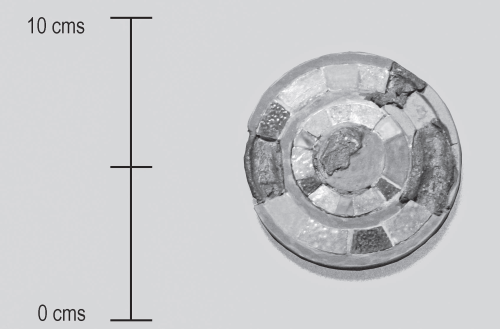
After Bettina Bader
“The round metal object with inlays, identified as a “pectoral” by the excavators, was heavily restored due to the poor condition of the metal parts. Owing to its green corrosion, the metal presumably consists of copper as the main component. […] found in Sedment tombs 2108 […]
Some parts of the metal disc in which the inlays were set are still preserved and were integrated into the modern restoration. Two concentric rings of inlays composed of blue and dark brown/black faience27 and carnelian form the main design of the object. The inlays are shaped as segments. The colour pattern in both rings seems to alternate one carnelian and one blue faience inlay with one dark brown/black faience and one blue faience inlay. The pattern of the outer ring from the twelve o’clock position clockwise is as follows: carnelian (replica), blue faience, a gap, blue, black and blue faience, carnelian (replica), gap, black and blue faience. The inner ring shows the following colour pattern, again from the twelve o’clock position clockwise: blue faience, carnelian, gap, black and blue faience, carnelian, blue, black and blue faience, carnelian, blue faience, and a slightly yellowish/greenish faience segment. The outer and inner ring of
inlays are set at a distance of about 0.4 cm. Not enough is preserved of the centre of the disc to allow any idea of its original design. A rosette or single round inlay is possible, as is a solid metal centre like those found at Saqqara [photo below], tomb 1008 in Sedment, and Matmar. The diameter of the reconstructed disc is ca 7.5 cm and the thickness is about 0.7 cm.” [Bettina Bader]
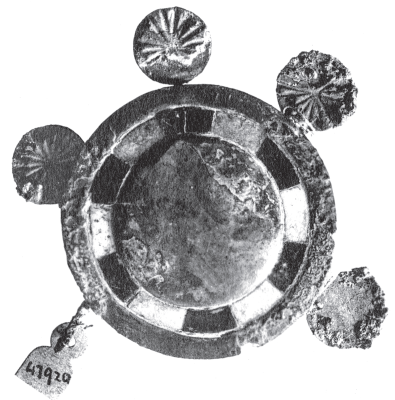
After Bettina Bader
“In the Teti cemetery, excavated by the Egyptian Antiquities Service in the 1920s, an object very similar in shape and concept to the artefact from Sedment came to light in tomb 6 (fig. 3).74 This object was identified as a “head ornament” in the original publication, although the sketch of the find position of the objects does not seem to include it. Perhaps it is represented by one of the objects shown around the head of the deceased in the sketch, but other than being named as find no. 11, it is not described in any detail. A remark by Brunton sheds more light on the position of that object: “Mr. Firth tells me that the Saqqara specimen, when found, lay against the skull of the woman and seemed to have been sown on to a headband of linen.” The excavation report also stated that a cartonnage mask covered the head. As no description was given, it might have been very fragmentary and disintegrated. The metal disc is described as being made of silver and is currently displayed in the Egyptian Museum, Cairo (JE 47920). According to the excavators, one ring of segment-shaped inlays made of stone and faience was set into the silver disc. The inlays alternated in light and dark colour. The centre of the ornament was left blank, but four additional silver rosettes were welded to the edge of the object. One was badly corroded. This ornament was dated to the “Herakleopolitan Middle Kingdom” by the excavators, which might be equated with the later First Intermediate Period or perhaps the latter half of the 11th Dynasty after the reunification of Egypt by Nebhepetre-Mentuhotep II.” [Bettina Bader]

After Bettina Bader
“a funerary mask (Egyptian Museum, Cairo JE 36279) belonging to a certain Khety and found at Asyut includes a headband with a round ornament on the brow that is exactly like the object from Sedment described above. It has been dated to the transition from the First Intermediate Period to the early Middle Kingdom […] and therefore falls into the same period as the cemeteries of Sedment.[…]
currently on display in the Egyptian Museum, Cairo (JE 36279). The disc-shaped ornament consists of two rings of coloured segments painted black, green, and red outlined in black, which are separated by white stripes; there are also white circles around the two rings of segments. The colour pattern of the outer ring from the twelve o’clock position clockwise is as follows: black, red, green, black, red, green, red, green, red, and green. That of the inner ring is: green, black, red, green, black, red, green, black, green, and red. It is interesting to note that the colour pattern is irregular in both rings. The same holds true for the disc found in Sedment. A red dot fills the centre of Khety’s disc. The red coloured elements on the mask most probably signify carnelian, while the green and black ones may well correspond to faience inlays similar to those found on the actual object from Sedment. The disc is attached (see below, tomb 1008 and Matmar tomb 306) to a multicoloured band fastened at the back of the head, with one streamer hanging down the wig. A lotus flower is shown on top of the knot at the back of the head. The headband is divided into multicoloured squares sequenced green, yellow, and red. The design closely resembles border patterns on stelae and coffins. On the headband it seems unlikely that such a pattern could represent the use of beads, because the square elements of the band do not imply such a technique. Moreover, the beads from Sedment tomb 2108 would appear to be of too many different sizes to form a feasible headband.” [Bettina Bader]

http://www.metmuseum.org/Collections/search-the-collections/591314

Middle Kingdom, Dynasty 11 to early Dynasty 12
2140–1926 B.C.
https://collections.mfa.org/objects/164600/mummy-mask?ctx=371d930c-bea5-45f9-ae7b-5f791e76a4bf&idx=428
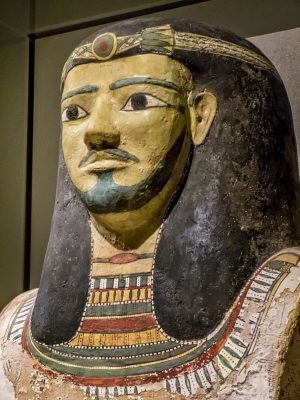
The Walters
Photo Mary Harrsch
https://www.flickr.com/photos/mharrsch/22512714368/
- Bettina Bader, Disc-shaped Ornaments of the Early Middle Kingdom, in Bulletin of the Egyptological Seminar 19, https://www.academia.edu
- Relations between Byblos, Egypt and Mesopotamia at the end of the third millenium B.C. A Study of a Montet Jar. [article]
O. Tufnell, W. A. Ward
Syria. Archéologie, Art et histoire Année 1966 43-3-4 pp. 165-241
https://www.persee.fr/doc/syria_0039-7946_1966_num_43_3_5872#syria_0039-7946_1966_num_43_3_T1_0172_0004
Qatna, 15th-14th century BCE

https://colorsandstones.eu/2023/11/19/medallion-an-ornament-of-a-diadem-ur-2500-bce-d-b/
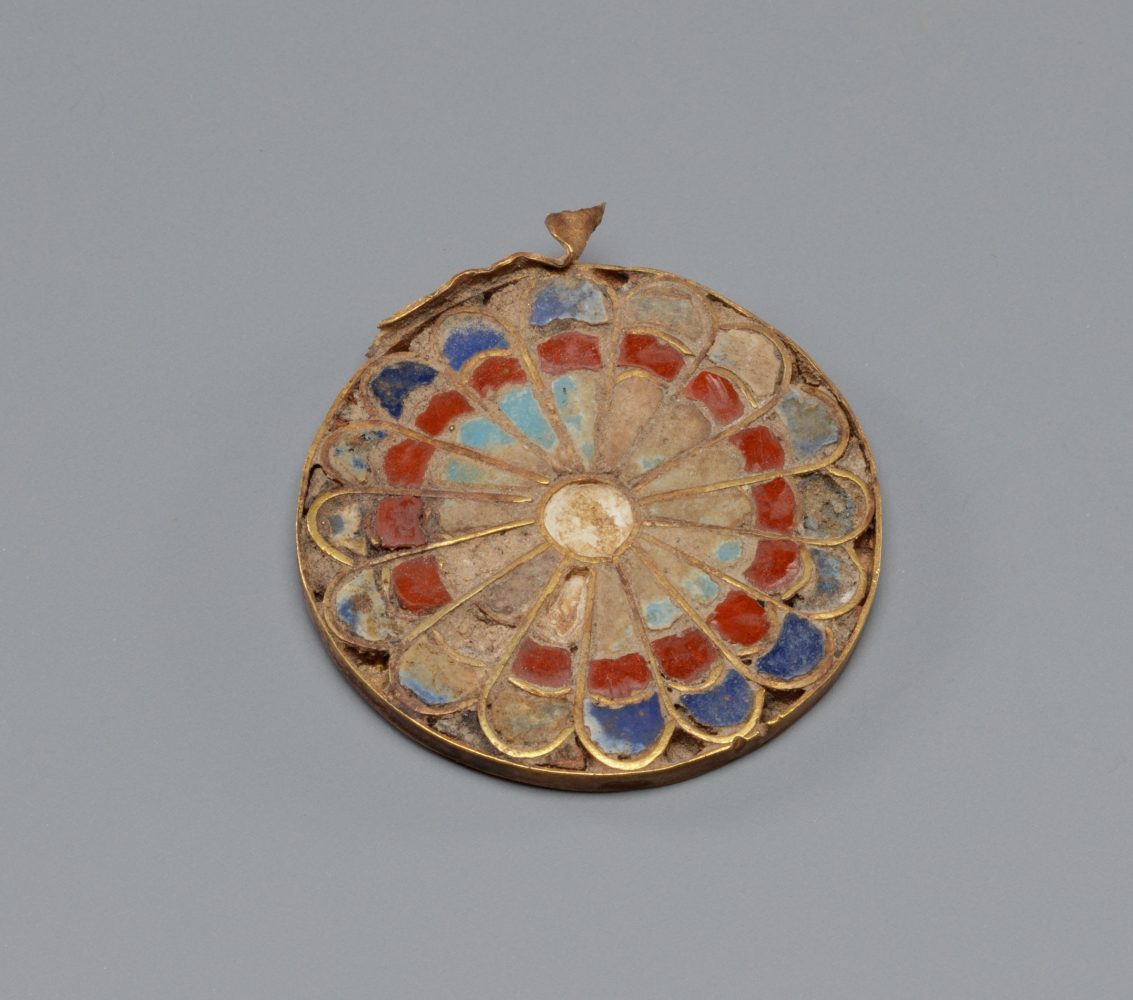
New Kingdom, ca. 1427–1400 B.C.
https://www.metmuseum.org/art/collection/search/548592

